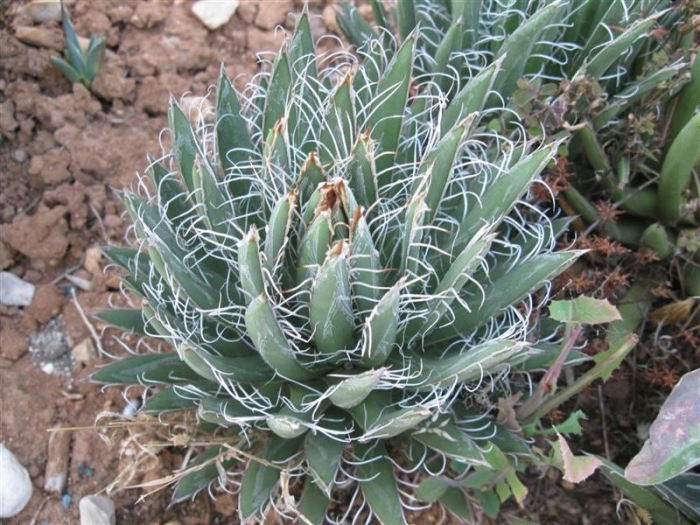Smallflower Century Plant
(Agave parviflora)
Smallflower Century Plant (Agave parviflora)
/
/

Juan Ignacio 1976
CC BY-SA 2.0
Image By:
Juan Ignacio 1976
Recorded By:
Copyright:
CC BY-SA 2.0
Copyright Notice:
Photo by: Juan Ignacio 1976 | License Type: CC BY-SA 2.0 | License URL: https://creativecommons.org/licenses/by-sa/2.0/ | Uploader: Juan Ignacio 1976 | Publisher: Flickr |
















Estimated Native Range
Summary
Agave parviflora, commonly known as Smallflower Century Plant, is an evergreen succulent native to the arid and semi-arid regions of Northwest Mexico and Arizona, particularly adapted to rocky outcrops and desert scrub environments. This compact agave forms a small rosette typically up to 25 cm (10 in) tall and 20 cm (8 in) wide. Its succulent leaves are up to 20 cm (8 in) long, presenting a waxy dark green color with distinctive white markings and curled fibers along the margins, which give it a unique appearance. During the summer, it produces a tall inflorescence, 1–2 m (3–7 ft) in height, bearing cream or pale yellow flowers that are attractive to pollinators such as bumblebees.
The Smallflower Century Plant is appreciated for its ornamental qualities, including its compact size and the striking contrast between its dark green leaves and white markings. It has earned the Royal Horticultural Society’s Award of Garden Merit, indicating its value in garden settings. It is particularly suited for rock gardens, xeriscaping, and as a specimen in containers due to its drought tolerance and low maintenance needs. It thrives in full sun to part shade and requires very little water once established, making it an excellent choice for water-wise gardens. Fast-draining soil is essential to prevent root rot. While generally disease-free, it can be susceptible to mealybugs and scale insects. This species is the smallest agave found in Arizona and is a prized collectible for succulent enthusiasts.CC BY-SA 4.0
The Smallflower Century Plant is appreciated for its ornamental qualities, including its compact size and the striking contrast between its dark green leaves and white markings. It has earned the Royal Horticultural Society’s Award of Garden Merit, indicating its value in garden settings. It is particularly suited for rock gardens, xeriscaping, and as a specimen in containers due to its drought tolerance and low maintenance needs. It thrives in full sun to part shade and requires very little water once established, making it an excellent choice for water-wise gardens. Fast-draining soil is essential to prevent root rot. While generally disease-free, it can be susceptible to mealybugs and scale insects. This species is the smallest agave found in Arizona and is a prized collectible for succulent enthusiasts.CC BY-SA 4.0
Plant Description
- Plant Type: Succulent
- Height: 0.3-0.5 feet
- Width: 0.4-0.6 feet
- Growth Rate: Slow
- Flower Color: Yellow
- Flowering Season: Summer
- Leaf Retention: Evergreen
Growth Requirements
- Sun: Full Sun, Part Shade
- Water: Very Low, Low
- Drainage: Fast
Common Uses
Bee Garden, Bird Garden, Drought Tolerant, Fire Resistant, Hummingbird Garden, Low Maintenance, Rabbit Resistant, Salt Tolerant, Street Planting
Natural Habitat
native to the arid and semi-arid regions of Northwest Mexico and Arizona, particularly adapted to rocky outcrops and desert scrub environments
Other Names
Common Names: Small-Flower Agave, Santa Cruz Striped Agave, Dvärgagave
Scientific Names: , Agave parviflora,
GBIF Accepted Name: Agave parviflora Torr.